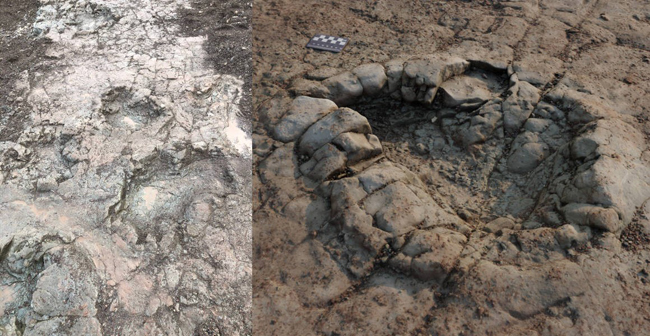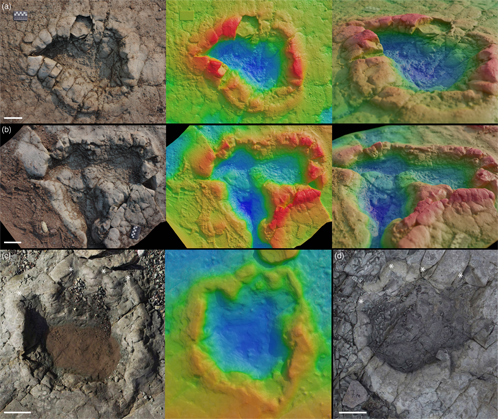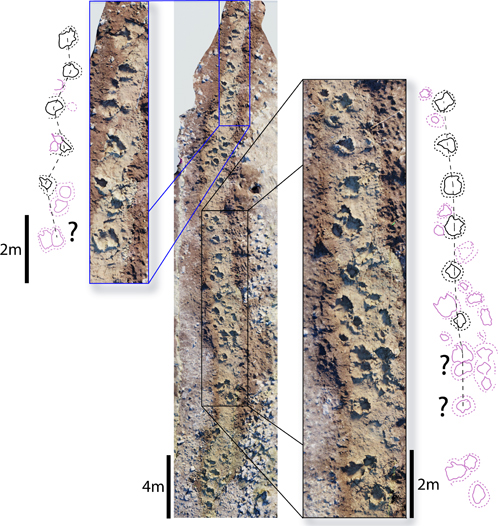Penarth Prints are Rare Dinosaur Tracks
A team of researchers writing in the journal “Geological Magazine”, have confirmed that the strange impressions exposed on the beach at Penarth (south Wales), are indeed dinosaur tracks. The site had been examined back in 2009, further evidence of tracks was revealed in 2020 after more of the bedding plane was laid bare by tidal erosion. The site some 800 metres south of Penarth pier, probably represents tracks made by different types of dinosaurs but they are too badly eroded for a more precise diagnosis other than to tentatively assign the largest, rounded tracks to the ichnogenus Eosauropus.

A part of the brushed and cleaned up trackway (left) with (right) a close-up view of a single print. Picture credit: NHM/Peter Falkingham.
Picture credit: NHM/Peter Falkingham
Carefully Mapped and Recorded
The tracks, some of which are more than 50 cm in diameter, are associated with the Upper Triassic Blue Anchor Formation. Although it is difficult to identify individual trackways, the high density of impressions suggests that the area was a trample ground that might have been visited by many individuals. Although the number of taxa making these impressions cannot be reliably inferred because of their poor preservation, based on their large size, round shape and digit impressions, the research team consider it likely that they were made by large sauropodomorph dinosaurs. As such, Late Triassic sauropodomorph tracks are exceptionally rare and the research team, which consisted of scientists from Liverpool John Moores University, the London Natural History Museum, Cardiff University, the University of Lyon and National Museum of Wales, conclude that these tracks provide additional information regarding the Late Triassic biota of the UK.

Detail images of individual tracks. (a) Individual D-shaped impression recorded in 2020, presented as photo-textured and height-mapped digital models. (b) Two to three overlapping impressions recorded in 2020, with a displacement rim spanning the centre of the deepest areas, presented as photo-textured and height-mapped digital models. (c, d) Individual tracks recorded during 2009, but showing clearer morphology in the displacement rims that we interpret as digit impressions (marked with *) (c). White scale bar = 10 cm. Picture credit: Falkingham et al.
Picture credit: Falkingham et al.
Likely to be Eroded Away in Just a Few Years
The team highlight the rapidly eroding site, more than one metre of the exposed surface has been lost since the first examination made in 2009 and the detailed mapping carried out in 2020. The loss of the bedding surface highlights the transient and vulnerable nature of these fossils. The site has been extensively photographed and mapped digitally ensuring that a computer record of these trace fossils can be stored in perpetuity.

Possible trackways observed on the northern surface, photo-textured models and interpretive outlines; dashed lines indicate extent of displacement rims. Picture credit: Peter Falkingham et al.
Picture credit: Peter Falkingham et al.
Team members from Everything Dinosaur visited the area in 2019 and had planned to return the following year to help record the tracks, unfortunately, COVID-19 restrictions prevented this. Still, this new study published this week confirms the presence of sauropodomorph tracks along the coastline and provides additional information on the Late Triassic biota of the British Isles.
The scientific paper: “Late Triassic dinosaur tracks from Penarth, south Wales” by Peter L. Falkingham, Susannah C. R. Maidment, Jens N. Lallensack, Jeremy E. Martin, Guillaume Suan, Lesley Cherns, Cindy Howells and Paul M. Barrett published in the journal Geological Magazine.

